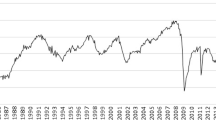Abstract
This paper presents an empirical assessment of productivity changes within the Korean Construction Management (CM) industry using a non-parametric Malmquist bootstrap methodology. For the purposes of this paper, the Global Malmquist productivity index (MPIG)-based productivity measurement procedure is designed to evaluate changes in productivity within the CM market between 2006 and 2012. To do so, it uses data from public announcements related to CM capabilities. Productivity estimates were statistically verified using the bootstrapping method. As a result of these estimations, this study showed that despite quantitative industry-wide growth, the average productivity of the service business firms in the Korean CM industry did not increase between 2006 and 2012. In total, the productivity of Korean CM firms were affected by environmental factors, including changes in the businesses cycle of the CM industry. Decreases in a firm’s managerial and strategic capabilities resulted in a parallel decline in that firm’s actual productivity, despite technical advances in the market. Efforts to promote technical efficiency among some firms, however, could overcome technological declines in the market.
Similar content being viewed by others
References
Caves, D. W., Christensen, L. R., and Diewert, W. (1982). “The economic theory of index numbers and the measurement of input, output, and productivity.” Econometrica: Journal of the Econometric Society, pp. 1393–1414.
Charnes, A., Cooper, W. W., and Rhodes, E. (1978). “Measuring the efficiency of decision making units.” European Journal of Operational Research, Vol. 2, No. 6, pp. 429–444.
Chau, K. W. and Walker, A. (1988). “The measurement of total factor productivity of the Hong Kong construction industry.” Construction Management and Economics, Vol. 6, No. 3, pp. 209–224.
Chen, Y. (2003). “A non-radial Malmquist productivity index with an illustrative application to Chinese major industries.” International Journal of Production Economics, Vol. 83, No. 1, pp. 27–35.
Chiang, Y. H., Li, J., Choi, T. N. Y., and Man, K. F. (2012). “Comparing China Mainland and China Hong Kong contractors’ productive efficiency: A DEA Malmquist Productivity Index approach.” Journal of Facilities Management, Vol. 10, No. 3, pp. 179–197, DOI: 10.1108/14725961211245992.
Cook, W. D. and Seiford, L. M. (2009). “Data envelopment analysis (DEA)–Thirty years on.” European Journal of Operational Research, Vol. 192, No. 1, pp. 1–17, DOI: 10.1016/j.ejor.2008.01.032.
Crawford, P. and Vogl, B. (2006). “Measuring productivity in the construction industry.” Building Research & Information, Vol. 34, No. 3, pp. 208–219.
Fare, R., Grosskopf, S., and Lovell, C. K. (1994). Production frontiers, Cambridge University Press.
Fare, R., Grosskopf, S., and Margaritis, D. (2011). Malmquist Productivity Indexes and DEA, Handbook on Data Envelopment Analysis, Springer, pp. 127–149.
Horta, I. M., Camanho, A. S., Johnes, J., and Johnes, G. (2013). “Performance trends in the construction industry worldwide: An overview of the turn of the century.” Journal of Productivity Analysis, Vol. 39, No. 1, pp. 89–99.
Li, Y. and Liu, C. (2010). “Malmquist indices of total factor productivity changes in the Australian construction industry.” Construction Management and Economics, Vol. 28, No. 9, pp. 933–945, DOI: 10.1080/01446191003762231.
Malmquist, S. (1953). “Index numbers and indifference surfaces.” Trabajos de Estadistica y de Investigacion Operativa, Vol. 4, No. 2, pp. 209–242.
Pastor, J. T. and Lovell, C. A. (2005). “A global Malmquist productivity index.” Economics Letters, Vol. 88, No. 2, pp. 266–271.
Portela, M. C. and Thanassoulis, E. (2010). “Malmquist-type indices in the presence of negative data: An application to bank branches.” Journal of Banking & Finance, Vol. 34, No. 7, pp. 1472–1483.
Simar, L. and Wilson, P. W. (1999). “Estimating and bootstrapping Malmquist indices.” European Journal of Operational Research, Vol. 115, No. 3, pp. 459–471.
Tortosa-Ausina, E., Grifell-Tatje, E., Armero, C., and Conesa, D. (2008). “Sensitivity analysis of efficiency and Malmquist productivity indices: An application to Spanish savings banks.” European Journal of Operational Research, Vol. 184, No. 3, pp. 1062–1084, DOI: 10.1016/j.ejor.2006.11.035.
Wang, C. H., Lee, J. Y., and Chang, Y. H. (2012). “Measuring productivity in the biotechnology industry using the global Malmquist index.” Applied Economics Letters, Vol. 19, No. 9, pp. 807–812.
Wang, X., Chen, Y., Liu, B., Shen, Y., and Sun, H. (2013). “A total factor productivity measure for the construction industry and analysis of its spatial difference: A case study in China.” Construction Management and Economics, Vol. 31, No. 10, pp. 1059–1071.
Xue, X., Shen, Q., Wang, Y., and Lu, J. (2008). “Measuring the productivity of the construction industry in China by using DEAbased Malmquist productivity indices.” Journal of Construction Engineering and Management, Vol. 134, No. 1, pp. 64–71.
You, T. and Zi, H. M. (2007). “The economic crisis and efficiency change: Evidence from the Korean construction industry.” Applied Economics, Vol. 39, Nos. 13-15, pp. 1833–1842, DOI: 10.1080/00036840600690199.
Zhi, M., Hua, G. B., Wang, S. Q., and Ofori, G. (2003). “Total factor productivity growth accounting in the construction industry of Singapore.” Construction Management and Economics, Vol. 21, No. 7, pp. 707–718.
Author information
Authors and Affiliations
Corresponding author
Rights and permissions
About this article
Cite this article
Lee, YS., Kim, JJ. & Lee, T.S. Measuring productivity changes in the Korean construction management industry. KSCE J Civ Eng 20, 2154–2161 (2016). https://doi.org/10.1007/s12205-015-0476-z
Received:
Accepted:
Published:
Issue Date:
DOI: https://doi.org/10.1007/s12205-015-0476-z




